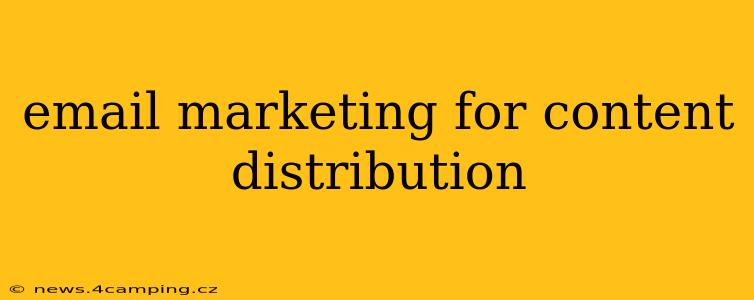Email marketing remains a potent tool for content distribution, offering a direct line to your audience and a high return on investment compared to other methods. This guide explores how to leverage email effectively to share your content and build a thriving community.
What is Email Marketing for Content Distribution?
Email marketing for content distribution involves using email newsletters and targeted campaigns to share your valuable content—blog posts, ebooks, webinars, case studies, and more—with your subscribers. It's a powerful way to nurture leads, boost brand awareness, and drive traffic to your website. Unlike social media, where algorithms can limit reach, email allows you to directly connect with your audience, fostering a loyal following and strengthening relationships.
Why Use Email Marketing for Content Distribution?
There are numerous reasons why email marketing remains a top choice for content distribution:
- High Engagement: Email delivers content directly to subscribers' inboxes, leading to higher open and click-through rates than other channels.
- Targeted Reach: Segment your audience based on demographics, interests, and behavior to deliver highly relevant content. This personalized approach increases engagement and conversion rates.
- Cost-Effectiveness: Email marketing is relatively inexpensive compared to other advertising channels, providing a significant return on investment.
- Measurable Results: Track key metrics such as open rates, click-through rates, and conversions to optimize your campaigns and improve performance.
- Relationship Building: Regularly engaging with your audience via email nurtures relationships, builds trust, and creates brand loyalty.
How to Effectively Use Email Marketing for Content Distribution?
1. Build a High-Quality Email List:
This is the foundation of successful email marketing. Focus on organic growth through website opt-in forms, lead magnets (like ebooks or checklists), and valuable content offers. Avoid buying email lists, as this can damage your sender reputation and lead to deliverability issues.
2. Segment Your Audience:
Dividing your list into smaller, more targeted segments allows you to send personalized content that resonates with each group. Consider segmenting by interests, demographics, purchase history, or engagement levels.
3. Create Compelling Email Content:
Your email subject line is crucial; make it enticing and relevant to your content. The email body should be concise, visually appealing, and highlight the value proposition of your content. Include a clear call to action (CTA) that encourages recipients to click and engage.
4. Choose the Right Email Marketing Platform:
Several platforms offer various features, including email automation, segmentation, and analytics. Select a platform that aligns with your budget and needs.
5. Track and Analyze Your Results:
Regularly monitor your email marketing metrics, such as open rates, click-through rates, and conversions. This data helps you understand what's working and what needs improvement.
What are the Best Practices for Email Marketing Content Distribution?
- Maintain a consistent email schedule: Regular communication keeps your audience engaged and reminds them of your brand.
- Personalize your emails: Use the subscriber's name and tailor the content to their interests.
- A/B test your subject lines and email content: Experiment with different versions to determine what resonates best with your audience.
- Optimize for mobile devices: Ensure your emails are responsive and look great on all devices.
- Follow email marketing best practices: Avoid spam triggers and comply with relevant regulations (like GDPR or CAN-SPAM).
What are Some Common Mistakes to Avoid in Email Marketing for Content Distribution?
- Ignoring list hygiene: Regularly remove inactive subscribers to improve deliverability and maintain a clean list.
- Sending irrelevant content: Make sure your content aligns with your subscribers’ interests to avoid unsubscribes.
- Ignoring analytics: Don't just send emails; track your results and adjust your strategy accordingly.
- Using poor design: Make your emails visually appealing and easy to read.
- Neglecting mobile optimization: Your emails should be viewable on all devices.
By implementing these strategies and avoiding common mistakes, you can effectively use email marketing to distribute your content, build a strong audience, and achieve your marketing goals. Remember, email marketing is an ongoing process requiring continuous refinement and adaptation. Stay updated with best practices and continuously experiment to optimize your campaigns for maximum effectiveness.
